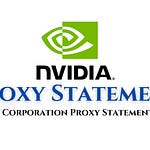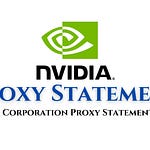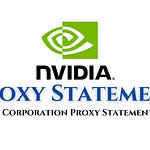NVIDIA Corporation 2020 Annual Review
Source: nVidia Proxy Statement for Stockholders Annual Report 2020
I. Executive Summary
NVIDIA Corporation (hereafter "NVIDIA" or "the Company") specializes in "accelerated computing, solving important challenges beyond the reach of normal computers," innovating "at the intersection of computer graphics, high performance computing, and AI." (Page 4). The Company's core business is real-time simulation of "worlds, physics, and intelligence." (Page 4). NVIDIA operates with a platform strategy, unifying hardware, system software, programmable algorithms, libraries, systems, and services, primarily leveraging their GPUs and CUDA as fundamental building blocks across diverse multi-billion-dollar end markets (Page 48, 50). The company's two reportable segments are GPU and Tegra Processor. (Page 48).
As of January 26, 2020, NVIDIA had 13,775 employees, with a significant majority (9,823) engaged in research and development. (Page 52). The company is headquartered in Santa Clara, California, and was reincorporated in Delaware in April 1998. (Page 48). NVIDIA is recognized as a "well-known seasoned issuer" and a "large accelerated filer" by the SEC. (Page 64).
II. Core Business and Technology
NVIDIA's innovation is centered around accelerated computing and AI, with a particular focus on real-time simulation.
Accelerated Computing & AI: NVIDIA addresses challenges that are beyond the capabilities of standard computers by innovating at the intersection of computer graphics, high-performance computing, and AI (Page 4). AI is described as "the most powerful technology force of our time and the engine driving our data center business. AI is software that learns to automate skills that require intelligence: the ability to perceive, reason, and plan." (Page 9).
GPU Product Brands: NVIDIA’s GPU products cater to specialized markets:
GeForce: For gamers (Page 48).
Quadro: For designers (Page 48).
Tesla and DGX: For AI data scientists and big data researchers (Page 48).
GRID: For cloud-based visual computing users (Page 48).
Tegra Processor: This segment integrates a complete computer onto a single chip, combining GPUs and multi-core CPUs. It powers "supercomputing for autonomous robots, drones, and cars, as well as for game consoles and mobile gaming and entertainment devices." (Page 48).
Real-time Ray Tracing (RTX): NVIDIA developed the world's first real-time ray-tracing GPU, which combines a ray-tracing accelerator and a deep learning Tensor Core processor. This technology aims to redefine gaming by creating "eye-popping images and deliver a level of photorealism never before seen in PC gaming." (Page 6). RTX is also used for "photorealistic rendering for design and film." (Page 9).
New Application Domains (2020 Milestones):NVIDIA RTX for photorealistic rendering for design and film (Page 9).
NVIDIA Aerial for 5G radio processing (Page 9).
NVIDIA Parabricks for next-generation genome sequencing (Page 9).
NVIDIA RAPIDS for data science and analytics (Page 9).
NVIDIA TensorRT for deep learning inferencing (Page 9).
VRWorks: A suite of software libraries provided to developers to enable "fully immersive experiences by enabling physically realistic visuals, sound, touch interactions, and simulated environments." (Page 50).
III. Sales and Marketing Strategy
NVIDIA's sales strategy involves working with end customers and various industry ecosystems through its partner network. (Page 51).
Global Reach: Sales and marketing teams are located across global markets, working closely with customers in each industry. (Page 51).
Partner Network: This network includes OEMs, ODMs, system builders, AIBs, retailers/distributors, internet and cloud service providers, automotive manufacturers and tier-1 automotive suppliers, mapping companies, and startups. (Page 51).
Evolved Avenues to Market: As the business shifted from gaming to broader markets and from chips to platforms, NVIDIA expanded its sales channels to include "e-tail channels, or direct to cloud service providers and enterprise customers." (Page 51).
Major Customer: Sales to Dell Technologies Inc. accounted for 11% of total revenue for fiscal year 2020. (Page 51).
Backlog: The company's sales are primarily based on standard purchase orders with short lead times, indicating that only a small, non-significant portion of the backlog is non-cancelable. (Page 51).
IV. Intellectual Property
NVIDIA prioritizes protecting its intellectual property through a combination of "patents, trademarks, trade secrets, employee and third-party nondisclosure agreements, and licensing arrangements." (Page 52).
Patent Expiration: Current issued patents have expiration dates ranging from March 2020 to October 2039. (Page 52).
International Protection: NVIDIA relies on international treaties and foreign laws, but acknowledges that protection may be less extensive in some countries, particularly in Asia, increasing the risk of piracy. (Page 52).
Licensing: The company licenses technology from third parties and expects to continue doing so. (Page 52). Intellectual property is also accessed by customers and partners through licenses and development agreements. (Page 51).
V. Financial and Corporate Governance Highlights
Revenue and Operating Income Targets (Fiscal 2020):Threshold: $10.5 billion revenue, $3.21 billion Non-GAAP Operating Income (50% payout) (Page 15, 27).
Base Operating Plan (Target): $11.4 billion revenue, $3.75 billion Non-GAAP Operating Income (100% payout) (Page 15, 27).
Stretch Operating Plan (Stretch): $12.0 billion revenue, $4.23 billion Non-GAAP Operating Income (200% payout for NEOs, 150% for CEO) (Page 15, 27).
Total Shareholder Return (TSR):Achieved a 3-year TSR ending Fiscal 2020 of 138% (95th percentile of S&P 500), which resulted in the maximum number of MY PSUs becoming eligible to vest. (Page 28).
Share Repurchase Program:Since August 2004, NVIDIA has repurchased 260 million shares for $7.08 billion through January 26, 2020. (Page 62).
As of January 26, 2020, NVIDIA was authorized to repurchase up to $7.24 billion in common stock through December 2022. (Page 62).
Equity Compensation Plans:The Amended and Restated 2007 Equity Incentive Plan authorizes various types of awards (stock options, RSUs, PSUs, etc.) to employees, directors, and consultants. (Page 71).
As of January 26, 2020, 29 million shares were available for future issuance under the 2007 Plan. (Page 71).
Dividends or dividend equivalents are not paid on unvested shares, and any credited dividends are subject to the same vesting conditions and forfeited if the underlying shares are forfeited. (Page 69).
The company implements stock ownership guidelines for executives and enforces "no-hedging" and "no-pledging" policies for common stock to align interests with shareholders. (Page 29).
VI. Leadership and Board of Directors
CEO and Founder: Jensen Huang has served as President and Chief Executive Officer and a director since 1993. He is described as "one of the technology industry’s most respected executives, having taken NVIDIA from a startup to a world leader in visual computing." (Page 19). He beneficially owned 3.77% of common stock as of March 22, 2020. (Page 22).
Board Composition: The document provides biographies of several director nominees, highlighting their diverse experience, including:
Robert K. Burgess: Independent investor and board member to technology companies, former CEO of Macromedia, Inc. (Page 18).
Tench Coxe: Managing Director at Sutter Hill Ventures, bringing expertise in financial and transactional analysis and corporate strategy. (Page 18).
Persis S. Drell: Provost of Stanford University, Professor of Materials Science and Engineering and Physics, and former Director of SLAC National Accelerator Laboratory. (Page 19).
Dawn Hudson: Independent Consultant, former Chief Marketing Officer for the NFL, and former president and CEO of Pepsi-Cola North America, bringing expertise in executive leadership, marketing, and corporate governance. (Page 19).
Harvey C. Jones: Managing partner of Square Wave Ventures, entrepreneur, high technology executive, and venture investor, co-founded Daisy Systems Corp. and Tensilica Inc. (Page 20).
VII. Risks and Legal Matters
General Risks: Investing in NVIDIA common stock involves risks, and any of the identified factors "could harm our business, financial condition, results of operations or reputation, which could cause our stock price to decline, and you may lose all or a part of your investment." (Page 53).
Intellectual Property Litigation: NVIDIA has been, is currently, and may in the future be involved in lawsuits alleging patent infringement or other intellectual property violations. Unfavorable rulings could lead to "significant damages, invalidation of a patent or family of patents, indemnification of customers, payment of lost profits, or, when it has been sought, injunctive relief." (Page 54). Such claims, regardless of merit, can incur significant costs and divert management attention. (Page 54).
Shareholder and Regulatory Proceedings: NVIDIA faces legal, administrative, and regulatory proceedings, including shareholder, consumer, and competition issues. For example, multiple securities litigation claims have been filed regarding "allegedly false and misleading statements related to channel inventory and the impact of cryptocurrency mining on GPU demand." (Page 55).
Change in Control Provisions: An agreement with Microsoft from March 5, 2000, grants Microsoft first and last rights of refusal to purchase shares if an individual or corporation offers to buy 30% or more of NVIDIA's outstanding common stock. This and other factors could "delay or prevent a change in control" and discourage proxy contests. (Page 55).
VIII. Miscellaneous
Social Media: NVIDIA actively uses various social media channels (Twitter, Company Blog, Facebook, LinkedIn, Instagram, YouTube) to disseminate information, some of which "may be deemed material." Investors are advised to monitor these alongside traditional financial reporting. (Page 64).
Cautionary Language: The annual report includes cautionary statements regarding forward-looking information, stating that "statements that “we believe” and similar statements reflect our beliefs and opinions on the relevant subject. These statements are based upon information available to us as of the filing date... and while we believe such information forms a reasonable basis for such statements, such information may be limited or incomplete, and our statements should not be read to indicate that we have conducted an exhaustive inquiry into, or review of, all potentially available relevant information. These statements are inherently uncertain and investors are cautioned not to unduly rely upon these statements." (Page 65).
Fabless Semiconductor Company: NVIDIA operates as a fabless semiconductor company, meaning it relies on third-party manufacturers, requiring commitments based on demand forecasts and accounting for lead times and constraints. (Page 63).













Share this post